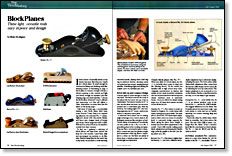Block Planes
These light, versatile tools vary in price and design
Synopsis: Mario Rodriguez has plenty of specialty planes, but he says he usually reaches for his block plane. It’s small and handy, compact and light. To evaluate what’s available on the market, he and his students put a few through some rigorous tests for several months in his shop. He explains how they’re made and how to use them and describes the types they tested. They evaluated the standard No. 9-1/2 planes, low-angle planes, Norris-style planes, and specialty planes. Rodriguez describes their differences and features, blade-depth adjustments, weight, and performance during use. He shows you how to tune up a plane and the fine points of using one.
I have dozens of specially planes at my bench, but more often than not, I reach for a block plane. It’s small enough for one-handed fitting and finishing tasks like trimming veneer or chamfering an edge. A block plane is compact enough to fit into a drawer opening to trim runners and light and handy enough for repetitive jobs like shaping pegs and small spindles. I choose the block plane whenever I need a delicate and responsive tool that will deliver a clean, tearout-free cut every time.
Until about 12 years ago, a woodworker buying a new block plane didn’t have many choices. Today, there is an expanding selection: the standard No. plane, high-tech planes with disposable blades, and fancy retro designs made of bronze and ebony. Prices range from $35 to $235. With such an array of choices, it’s natural to wonder how they compare.
To find out, I gathered a selection of block planes and kept them around the shop for a few months. I used them daily and encouraged my students to do likewise. Besides using them for the usual dayto-day tasks, we put them to work trimming veneered panels, planing down solid edging on plywood shelves, shooting seams on book-matched veneer, tapering slender spindles, chamfering edges and planing the outside curve of a bricklaid pine arch.
Bevel side up and compact design
A block plane is small enough to hold in one hand. The blade is set into the body of the plane with the bevel side up; it has no chip breaker. The blade is bedded at 20° or less, and the blade and lever cap are incorporated into a comfortable grip. With the bevel up, the cutting angle is 45° (the bedding angle plus the 25° bevel), which is the same as a standard bench plane.
A standard block plane has no cutting angle advantage over a bench plane in difficult grain situations like end grain or burl. I know plenty of experienced woodworkers who prefer to use a No. 4 or a No. 5 smoothing plane when working end grain. They say that a two-handed grip is essential to control and that the greater weight and momentum of the big plane is important to a clean cut. But there are plenty of times when a full-sized plane and a two handed grip are impractical.
From Fine Woodworking #119
For the full article, download the PDF below:
Fine Woodworking Recommended Products

Stanley Powerlock 16-ft. tape measure

Lie-Nielsen No. 102 Low Angle Block Plane

Veritas Micro-Adjust Wheel Marking Gauge























Log in or create an account to post a comment.
Sign up Log in